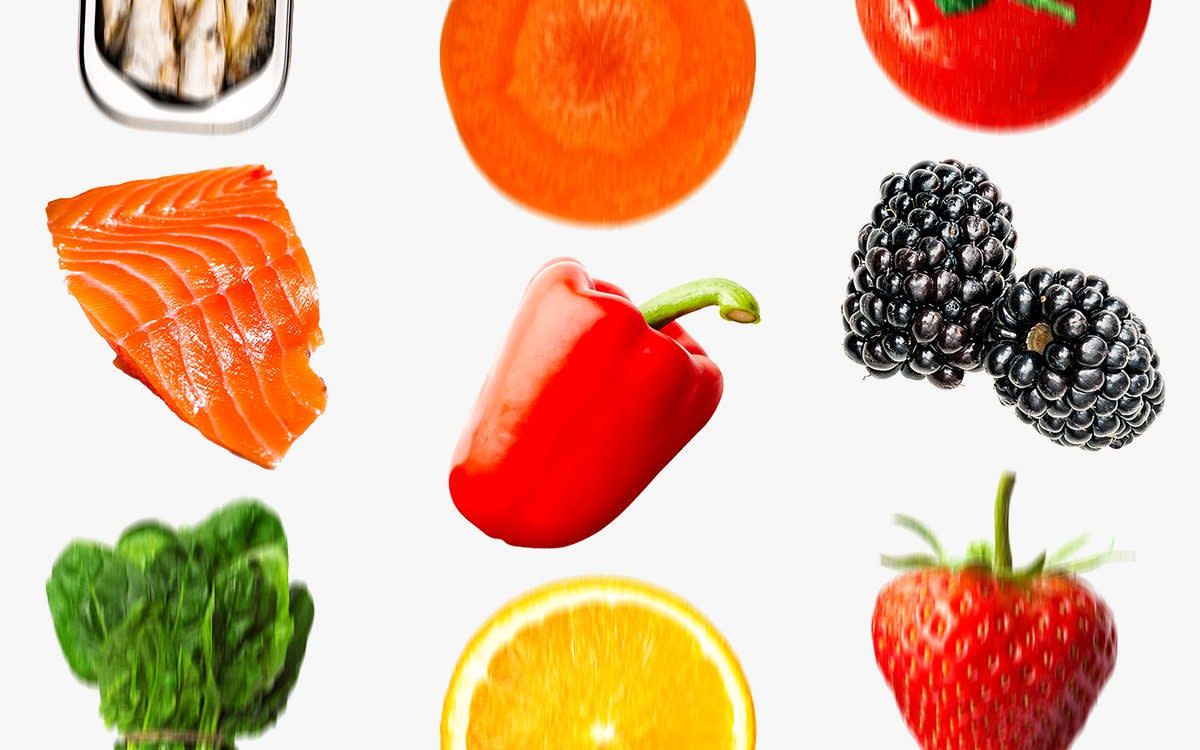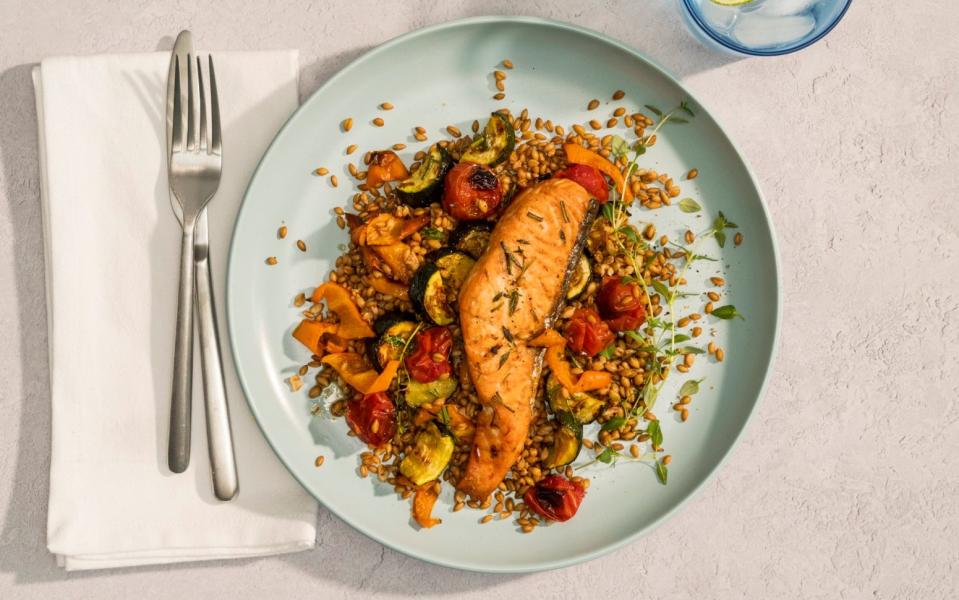The anti-inflammatory foods that will help you live longer – plus three recipes to try

Health and nutrition experts disagree about many things, but there’s one topic on which there’s general consensus: the benefits of eating a diet rich in anti-inflammatory foods. The evidence is now irrefutable, they say, that adopting this eating approach can reduce chronic inflammation and the risk of developing an array of diseases that go with it.
The foods that reduce inflammation
Twenty years ago, scientists started developing the Dietary Inflammatory Index (DII). Based on a wide range of robust scientific research, it identified foods, nutrients and compounds that are either anti-inflammatory or pro-inflammatory. The DII, which is constantly updated in line with the latest research, is used to give an individual’s diet a score, the lowest being anti-inflammatory and the highest pro-inflammatory.
“Many observational studies have reported lower rates of diseases such as colorectal cancer, obesity, cardiovascular disease, osteoporosis and asthma with lower DII scores,” says Dr Fiona Malcomson, a lecturer in human nutrition at Newcastle University.
Development of the DII has revealed that plant foods in particular contain inflammation-fighting compounds including polyphenols, antioxidants and fibre. “A plant-based diet also promotes healthy gut bacteria, “ Dr Bains says. “And the higher fibre content helps slow down digestion, which prevents surges in blood sugar levels, another common cause of inflammation.”

How to add them to your diet
The below three recipes are packed full of ingredients that studies suggest reduce – or even switch off – inflammation.
Skip to:
Three-greens pesto with mixed nuts and wholemeal spaghetti

Timings
Prep time: 15 minutes
Cook time: 10 minutes
Serves
Four
All the anti-inflammatory stars of the leafy greens world are smuggled into this moreish pesto sauce, as well as an abundance of different nuts. Each anti-inflammatory food contains its own array of active compounds and we all respond to foods differently. That’s why eating a wide range of anti-inflammatory foods covers all the bases for better health.
Ingredients
400g wholewheat spaghetti
50g cavolo nero or other kale, trimmed and sliced
70g broccoli, cut into small florets
50g baby spinach
1 small handful basil leaves
1 small handful fresh dill
80ml extra virgin olive oil
1 anchovy fillet in oil, drained
1 small garlic clove, roughly chopped
25g mixed nuts (any combination of walnuts, Brazil nuts, pistachios and almonds)
45g Parmesan, grated
1 tbsp lemon juice, plus extra to taste
Method
Bring a large pan of salted water to the boil, add the spaghetti and cook until al dente, about 8 minutes.
Meanwhile, steam the cavolo nero and broccoli together for 5 minutes until the cavolo nero is tender and the broccoli stalks are cooked but still firm to the point of a knife.
Transfer the cooked greens to a food processor and add the spinach, herbs, oil, anchovy, garlic, nuts, 25g of the Parmesan and the lemon juice, along with a generous pinch of salt.
Pulse until you have a mixture that’s still a little chunky with small pieces of nuts in it. Taste and add more lemon juice or salt if required.
Drain the spaghetti, reserving 4-5 tablespoons of the cooking water.
Return the spaghetti to the pan, add the pesto and mix so the strands are well coated. Add the reserved cooking water little by little, mixing well between additions, to loosen the sauce. Don’t add too much or the result will be watery.
Serve immediately, topped with the remaining Parmesan.
Roast salmon with melted tomatoes, roast vegetables and grains

Timings
Prep time: 10 minutes
Cook time: 30 minutes
Serves
4
Salmon is an oily fish that’s packed with omega-3 fatty acids, types of healthy fats that studies suggest reduce – or even switch off – inflammation. Most colourful vegetables have anti-inflammatory benefits, too, so pairing salmon with a rainbow selection of peppers and tomatoes provides an extra boost.
Ingredients
1 courgette (about 250g)
1 yellow or orange pepper, cut into thin strips
300g cherry tomatoes
60ml extra virgin olive oil
1 tbsp balsamic vinegar
1 fat garlic clove, crushed
2 tbsp finely chopped rosemary or thyme
1 pinch saffron threads, chopped (optional)
240g freekeh, pearl barley, farro or bulgur wheat
4 organic salmon fillets
Method
Preheat the oven to 220C/200C fan/gas mark 7.
Slice the courgette in quarters lengthways, then crossways into 1cm-wide pieces.
Line a roasting tin roughly 30cm x 23cm with baking parchment and add the courgette, pepper and tomatoes.
Place the oil, vinegar, garlic and herbs in a jar, tighten the lid and shake well. Pour over the vegetables, tossing them with your hands until everything is nicely coated. Roast for 30 minutes, or until the tomatoes have burst open and ‘melted’, releasing their juices.
While the vegetables are roasting, cook the grains according to the packet instructions.
Twelve minutes before the end of the vegetable roasting time, arrange the salmon skin-side down on top of the vegetables, and brush with the tray juices. Return to the oven for 12 minutes, or until the fish is just cooked through but still pink in the middle.
To serve, divide the grains between shallow bowls and spoon over the vegetables and juices. Top with the salmon and serve immediately.
Stovetop cherry-berry crumble with cocoa yogurt

Timings
Prep: 15 minutes
Cook time: 5 minutes
Serves
4
There’s strong evidence that high levels of healthy plant compounds in cherries are particularly effective at lowering levels of inflammation. But every ingredient in this flavour-packed dish (save for the dash of salt and vanilla) ticks the anti-inflammatory box. Enjoy for breakfast, dessert or as a snack.
Ingredients
For the crumble
120g jumbo oats
50g walnuts, roughly chopped
4 tbsp mixed seeds (any combination of sesame, pumpkin, sunflower or flax seeds)
½ tsp ground cinnamon
½ tsp ground turmeric
½ tsp ground ginger
3 tbsp extra virgin olive oil
4 tbsp maple syrup
For the cocoa yoghurt
400g plain Greek yogurt
1 tbsp cocoa powder
½ tsp vanilla extract
To serve
280g cherries (fresh, pitted, or frozen and defrosted)
160g raspberries (or other berries)
Method
Line a baking tray with baking parchment.
Combine the oats, walnuts, seeds, spices and ¼ tsp fine sea salt in a bowl.
Heat a large frying pan over a medium-high heat, add the olive oil and maple syrup and stir together. Add the oat mixture and stir it around in the syrupy oil until it’s well coated.
Fry the mixture, stirring constantly, for 4 minutes, or until it darkens slightly and starts to smell caramelised and toasty.
Spread the oat mixture out on the prepared baking parchment and leave to cool and crisp up a little.
Stir together the yogurt, cocoa and vanilla.
Divide the cocoa yogurt between bowls, top with the cherries and raspberries and sprinkle with the crumble mixture.


 Yahoo News
Yahoo News 
